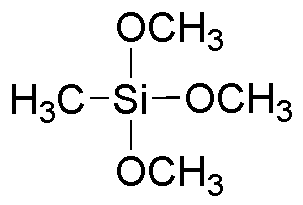Trimethoxymethylsilane is widely utilized in research focused on various applications:
- Silane Coupling Agent: It enhances adhesion between organic materials and inorganic substrates, making it valuable in coatings and sealants industries.
- Surface Modification: Used to modify surfaces of glass, metals, and ceramics, improving properties like hydrophobicity and chemical resistance, which is crucial in electronics and automotive sectors.
- Polymer Production: Acts as a crosslinking agent in silicone and other polymer formulations, providing improved thermal stability and mechanical strength, beneficial in manufacturing durable products.
- Adhesives and Sealants: Its incorporation in formulations leads to better bonding performance, particularly in construction and automotive applications where strong, reliable seals are essential.
- Research Applications: Commonly used in laboratories for synthesizing silane-based compounds, facilitating studies in material science and nanotechnology due to its versatile reactivity.
General Information
Properties
Safety and Regulations
Applications
Trimethoxymethylsilane is widely utilized in research focused on various applications:
- Silane Coupling Agent: It enhances adhesion between organic materials and inorganic substrates, making it valuable in coatings and sealants industries.
- Surface Modification: Used to modify surfaces of glass, metals, and ceramics, improving properties like hydrophobicity and chemical resistance, which is crucial in electronics and automotive sectors.
- Polymer Production: Acts as a crosslinking agent in silicone and other polymer formulations, providing improved thermal stability and mechanical strength, beneficial in manufacturing durable products.
- Adhesives and Sealants: Its incorporation in formulations leads to better bonding performance, particularly in construction and automotive applications where strong, reliable seals are essential.
- Research Applications: Commonly used in laboratories for synthesizing silane-based compounds, facilitating studies in material science and nanotechnology due to its versatile reactivity.
Documents
Safety Data Sheets (SDS)
The SDS provides comprehensive safety information on handling, storage, and disposal of the product.
Product Specification (PS)
The PS provides a comprehensive breakdown of the product’s properties, including chemical composition, physical state, purity, and storage requirements. It also details acceptable quality ranges and the product's intended applications.
Certificates of Analysis (COA)
Search for Certificates of Analysis (COA) by entering the products Lot Number. Lot and Batch Numbers can be found on a product’s label following the words ‘Lot’ or ‘Batch’.
*Catalog Number
*Lot Number
Certificates Of Origin (COO)
This COO confirms the country where the product was manufactured, and also details the materials and components used in it and whether it is derived from natural, synthetic, or other specific sources. This certificate may be required for customs, trade, and regulatory compliance.
*Catalog Number
*Lot Number
Safety Data Sheets (SDS)
The SDS provides comprehensive safety information on handling, storage, and disposal of the product.
DownloadProduct Specification (PS)
The PS provides a comprehensive breakdown of the product’s properties, including chemical composition, physical state, purity, and storage requirements. It also details acceptable quality ranges and the product's intended applications.
DownloadCertificates of Analysis (COA)
Search for Certificates of Analysis (COA) by entering the products Lot Number. Lot and Batch Numbers can be found on a product’s label following the words ‘Lot’ or ‘Batch’.
*Catalog Number
*Lot Number
Certificates Of Origin (COO)
This COO confirms the country where the product was manufactured, and also details the materials and components used in it and whether it is derived from natural, synthetic, or other specific sources. This certificate may be required for customs, trade, and regulatory compliance.


